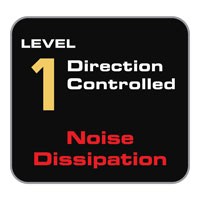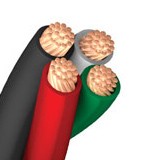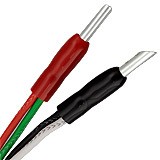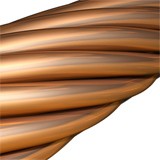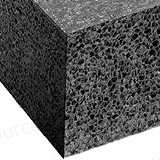Full Description
View Full Description
Please Note
The speaker cable included in this bundle is provided as one 25m length and unterminated.
AudioQuest Pearl 48Gbps High Speed HDMI Cable, 1m
AudioQuest HDMI 2.1 cables for 4K, 8K and 10K
AudioQuest offer the right HDMI cables for 4K TVs, 8K TVs, and beyond. All of AudioQuest’s new 48Gbps HDMI cables can transfer up to professional 10K Ultra-HD video. The impressive 48Gbps data rate is made possible by four balanced audio/video pairs capable of 12Gbps each. And, of course, the latest technology is backwards compatible with 4K displays.
Video Up to 10K
AudioQuest 48Gbps HDMI cables are completely backwards compatible with existing devices and have the bandwidth required for video with resolutions up to 10K and resolutions/refresh rates up to 8K/60 and 4K/120
HDR (High Dynamic Range)
All AudioQuest HDMI cables support HDR (High Dynamic Range) and Dynamic HDR. HDR content expands the contrast of the image for blacker blacks and brighter whites/highlights as well as greater colour saturation and brightness. In addition, 4K Ultra-HD content allows for a wider colour range.
This combination of technologies results in more realistic HDR images with greater perceived depth. Dynamic HDR (HDR10+ and Dolby Vision, for example) enables frame-by-frame HDR optimization rather than HDR settings that are fixed for the entire program. The most prominent current HDR formats are HDR10, HDR10+, and Dolby Vision. AudioQuest 18Gbps and 48Gbps HDMI cables are compatible with all varieties of HDR, which can be found on Ultra-HD Blu-ray, and all major streaming services, including Netflix, Amazon Prime, Disney+, Apple TV+, and others.
ARC (Audio Return Channel) and eARC (enhanced Audio Return Channel)
HDMI’s Audio Return Channel (ARC) sends audio from a TV to a soundbar or AV receiver for greater simplicity and flexibility in system setup. Hardware’s previous ARC capabilities max out at lossy (compressed) 5.1-channel surround sound.
Today’s HDMI 2.1 hardware supports enhanced Audio Return Channel (eARC), which increases the digital bandwidth dramatically to support uncompressed and lossless high-resolution multichannel audio, including Dolby TrueHD and Atmos, and DTS-HD Master Audio and DTS: X. Not only do all current generations of AudioQuest HDMI cables have the conductors and bandwidth required for eARC’s enhanced sonic capabilities, but, in order to ensure superior audio performance, the ARC-channel conductor-pair is internally controlled for direction, running in the opposite direction from the 4 pairs that carry information to the TV. Finally, AudioQuest’s eARC-Priority models include 4 Silver-Plated Forest 48-level audio/video data pairs—but with a far superior single data pair for the TV’s audio output. By upgrading the ARC data path only, audiophile quality is made possible at a fraction of the cost of upgrading all 5 data pairs.
Solid Long-Grain Copper
Maximize Noise Dissipation and overall performance
Noise Dissipation
Six Levels of Noise Dissipation (ND) combat distortion caused by RF Noise contaminating digital and analog circuitry
eARC
Because sound is where all the emotion and drama comes from, AQ’s eARC channel gets 100 the same love as the four AV channels
Lifetime Warranty
AudioQuest have got your back. Performance backed by reliability
48 Gbps
The 48Gbps necessary for all of HDMI’s new and future features is made possible by upgrading the 4 AV channels from 6 to 12Gbps
AudioQuest Pearl Digital Optical Cable, 1.5m
The AudioQuest Pearl digital optical cable features a low-dispersion fibre conductor for low-jitter and is ideal for connecting all manner of devices from TV's to Sky+ HD boxes, computers, media streamers, Blu-Ray players and games consoles. With better materials used in the construction - better polymers and quartz for example - the result is an enjoyable listen that's free from interruption.
Pearl OptiLink Features
The audio frontier is abuzz these days with the pleasure possible though HDMI, USB, FireWire® and Ethernet connections. However, these current generation digital technologies are only part of the story, just as the challenge of designing, manufacturing and choosing the best analogue interconnects and speaker cables is as important as ever. The S/P-DIF (Sony Philips Digital InterFace), which arrived in 1983 along with the CD, is still very much a part of our world today. S/P-DIF is transmitted through Digital Coax and Toslink fibre optics (EIA-J), making them still some of the most important cables in electronic entertainment.
While, thanks to HDMI, Toslink is not so often used to connect a DVD player to an A/V receiver, Toslink connectors are common on cable-boxes, TV sets, subwoofers, all sorts of products. And now, the 3.5mm Mini Optical connector, also somewhat incorrectly known as Mini-Toslink, is everywhere... from the 3.5mm dual-purpose headphone jack on a Mac laptop, to inputs on some of the finest portables.
"How can digital optical cables change the sound?"
The answer is easier to explain than for almost any other type of cable. If the light source were a coherent laser, firing into a vacuum, all the light would stay straight, arriving at its destination at the same time. Even if the LED light source in a Toslink system were coherent, the light entering a fibre-optic cable is scattered and dispersed by imperfections and impurities in the fibre. This can be measured as a loss of amplitude ... but amplitude is not the problem, a 50 true loss would have no effect on sound quality.
The problem is that the dispersed light does get through the cable, but only after it has taken a longer path, like a pool ball bouncing off the side-rails, causing it to arrive later. This delayed part of the signal prevents the computer charged with decoding this information from being able to decode properly, or even at all. The inability to decode shows first at higher frequencies (not audio frequencies, this is a mono stream of digital audio information), so reduced bandwidth is a measurable signature of light being dispersed by a fibre. The punch line: The less dispersion in the fibre, the less distortion in the final analogue audio signal presented to our ears.
There is another serious dispersal mechanism in the Toslink system. The fibre is a relatively huge 1mm in diameter, and the LED light source is also relatively large, spraying light into the fibre at many different angles. Even if the fibre were absolutely perfect, the signal would be spread across time because light rays entering at different angles take different length paths and arrives with different amounts of delay.
The almost complete solution to this problem is to use hundreds of much smaller fibres in a 1mm bundle. Because each fibre is limited as to what angle of input can enter the fibre, there is far less variety, and far less dispersion over time. This narrow-aperture effect is similar to how a pin-hole camera can take a picture without a lens ... by letting in light at only a very limited range of angles, a picture can be taken, whereas removing the lens from a wider aperture would make photography impossible. Less light gets through a multi-fibre cable, but the light that does get into the fibres comes out within in a much smaller time-envelope.
- Low-Dispersion Fibre
- Low-Jitter (Digital Timing Errors)
- Precision Polished Fibre Ends
- Black / Gray Stripe In-Wall Rated PVC
AudioQuest SLiP-DB 16/2 Install Speaker Cable, White
AudioQuest SLiP/DB speaker cable is a super-flexible two core cable suitable for single speaker use. The protective outer jacket is sleek enough to easily thread through walls and it's fire-rated making SLiP/DB the perfect choice for high end in-wall or in ceiling speakers as well as for wiring throughout a home cinema.
Sometimes, pulling cable can be a real pain! AudioQuest's SLiP/DB series of in-wall speaker cables have been designed to make your life a little easier when installing behind walls and cavities. While there is no perfectly slippery cable, the materials and shape used for SLiP/DB are at the forefront, making these the most slippery cables possible.
The AudioQuest SLiP/DB 16/2 speaker cable comes in a more clandestine white outer jacket or the traditional dark grey.
Semi-Solid Concentric Packed Conductors
In a conventional multi-strand cable, distortion caused by electrical and magnetic strand interaction is compounded as each strand changes position within the bundle. In an AQ Semi-Solid Concentric Packed cable, strands within the bundle maintain their fixed relationships, significantly reducing distortion.
Terminations
A quality cable demands a quality termination. Cable stripped bare wire and even DIY plugs leave the copper conductors exposed to signal-degrading oxygen which will require the cable to be re-terminated over time.
AudioQuest SLiP/DB 16/2 speaker cable can be specially terminated with a range of plug crimp options, this seals in the copper leaving a neat connection.
- Semi-solid concentric packed long-grain copper (LGC) conductors
- 2 x 16 AWG (1.31mm²)
- PVC jacket (CL3 and CEC FT4 Fire Rating)
- Suitable for outdoor use
AudioQuest Black Lab Subwoofer Cable, 3m (Single)
Black Lab is the start-off canine-themed interconnect from AudioQuest to connect your active subwoofer to an amplifier or AV Receiver. This interconnect may be viewed as 'entry level' but we'd be more inclined to liken it as a cable suitable for any mid-range active 'woofers in the £200-£800 price range.
AudioQuest's have stayed loyal to their conductor philosophy of solid Long Grain Copper (LGC), a technique that eliminates strand interaction (being more like a long core of solid copper). A smoother and clearer sound is achieved than regular standard-issue OFC cables and contains less oxides, less impurities and fewer grain boundaries (where the end of one meets the start of another).
Top-notch Polyethylene insulation and an integrated system to combat noise are all unmistakable features of AudioQuest Black Lab and rather than soldering RCA plugs to terminate the cable AQ strongly believe in a 'cold-weld' connection to avoid distortion and a better choice of metals that isn't dictated by machinery.
The Black Lab also comes complete with a useful grounding lug, which will help to eliminate any subwoofer hum you may come across. Simply attach one spade lug to the metal chassis of the subwoofer's amplifier block and the other spade to the chassis of the AV receiver or amplifier. Certainly one of the only subwoofer cables to include one at this price point. Excellent attention to detail from AudioQuest!
AudioQuest Black Lab Features
Solid LGC Conductors
Conductor material quality makes a world of difference in the sound of an audio cable. Since the surface of a conductor has 100 current density at all frequencies, the surface most defines the sound quality of the whole conductor. The less complicated grain structure and fewer impurities within Black Lab's LGC copper significantly reduce distortion compared to normal high-purity copper.
Solid Core Conductors
Strand interaction is the single greatest cause of distortion in cable, and one of the easiest to avoid. Whenever current crosses the oxidized contact between bare strands, the signal will be altered. In addition, the magnetic fields of the various strands are constantly interacting, causing confusion (smearing) and causing the contact pressure between strands to be constantly modulated. AudioQuest's solid core conductors are the complete solution to this problem.
AudioQuest Noise-Dissipation System
Noise, in the form of RF energy, is the mortal enemy of good sound. Our environment is more contaminated with RF than ever before due to the huge proliferation of RF radiating devices like computers and mobile phones. Traditionally, RF energy is routed to ground through the use of a 'shield" consisting of either a braided metal or foil. This 'draining' of RF to ground causes a modulation of the ground plane, which in turn causes a form of signal modulation. AudioQuest's Noise-Dissipation System greatly reduces the effect of this modulation. Metal, used in a passive manner, acts as a method of dissipating and reducing the incoming RF. The result is dramatically less modulation of the signal, less distortion and better sound.
Cold-Weld System
Making the perfect connection between conductor and connector is not a simple process. There are three accepted ways to make the connection between a cable and its termination. Solder is by far the most common method of connection. Resistance welding is clearly superior to even the best solder. However, just as solder introduces an inferior layer of differing material, causing distortion and reflections, so does welding. The alloy created at the interface of cable and plug is far superior to solder, but it is still an undesirable intermediary layer. After so much attention to the quality of the conductor and connector, the contact system deserves just as much consideration. AudioQuest's Cold-Weld System solves this problem with a superior connection that insures that the structural integrity of the conductor is kept completely intact. The Cold-Weld System refers to a combination of high pressure at the point of contact and the use of silver impregnated paste.
Foamed Polyethylene Insulation
Any solid material adjacent to a conductor is actually part of an imperfect circuit. Wire insulation and circuit board materials all absorb energy (loss). Some of this energy is stored and then released as distortion. Black Lab uses air-filled Foamed-Polyethylene Insulation on both conductors because air absorbs next to no energy and Polyethylene is low-loss and has a benign distortion profile. Thanks to all the air in Foamed-PE, it causes much less of the out-of-focus effect common to other materials.
Package includes
Cable Specifications
Specifications: AudioQuest Pearl 48Gbps High Speed HDMI Cable
| Bandwidth | 48Gbps 8K-10K |
|---|
| A/V Conductor | Solid Long-Grain Copper (LGC) |
|---|
| eARC Conductor | Solid Long-Grain Copper (LGC) |
|---|
| Ground Reference | Tinned Copper |
|---|
| Noise-Dissipation | All 19 Conductors Direction-Controlled |
|---|
Specifications: AudioQuest Pearl Digital Optical Cable
| Conductor | Low-Dispersion Fibre |
|---|
| Jacket | PVC |
|---|
| Terminations | Standard Toslink (Both Ends) |
|---|
| Type | Digital Optical Cable |
|---|
Specifications: AudioQuest Black Lab Subwoofer Cable
| Conductor | Long-Grain Copper (LGC) |
|---|
| Dielectric | Foamed Polyethylene |
|---|
| Jacket | PVC |
|---|
| Plug Type | Gold-Plated RCA Male (x2) |
|---|
| Shielding | Standard NDS |
|---|
| Type | Subwoofer Interconnect |
|---|


























